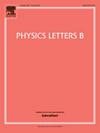与fastec的ν点能量相关器:来自大型强子对撞机射流的小x物理
IF 4.3
2区 物理与天体物理
Q1 ASTRONOMY & ASTROPHYSICS
引用次数: 0
摘要
近年来,能量相关器已成为研究射流子结构的有力工具,在探测强子化跃迁、分析夸克-胶子等离子体以及提高顶夸克质量测量精度等方面具有广阔的应用前景。投影的N点相关器通过跟踪N个最终态粒子之间的最大分离来测量它们之间的相关性,显示出与dlap分裂函数相关的缩放行为。这些相关器可以解析地在N中连续,通常称为ν-相关器,允许访问分裂函数的非整数矩。特别有趣的是ν→0极限,在那里分裂函数的小动量分数行为需要恢复。最初,评估M粒子的ν-相关器的计算复杂性缩放为22M,使其无法用于现实世界的分析。然而,通过使用递归,我们将其减少到M2M,并且通过动态解析主题的FastEEC方法,M被主题的数量所取代。这一突破首次使计算LHC数据的ν相关器成为可能。在实践中,将主题的数量限制在16就足以达到百分比级别的精度,我们使用已知的整数ν和非整数ν的收敛性测试来验证这一点。我们已经在fastec的更新中实现了这一点,并使用CMS开放数据对喷气机进行了微扰状态下的幂律缩放作为ν的函数的初步研究。结果与DGLAP的演化一致,除了在小ν处,异常维数饱和到与BFKL异常维数匹配的值。本文章由计算机程序翻译,如有差异,请以英文原文为准。
ν-point energy correletors with FastEEC: Small-x physics from LHC jets
In recent years, energy correlators have emerged as a powerful tool for studying jet substructure, with promising applications such as probing the hadronization transition, analyzing the quark-gluon plasma, and improving the precision of top quark mass measurements. The projected N-point correlator measures correlations between N final-state particles by tracking the largest separation between them, showing a scaling behavior related to DGLAP splitting functions. These correlators can be analytically continued in N, commonly referred to as ν-correlators, allowing access to non-integer moments of the splitting functions. Of particular interest is the limit, where the small momentum fraction behavior of the splitting functions requires resummation. Originally, the computational complexity of evaluating ν-correlators for M particles scaled as , making it impractical for real-world analyses. However, by using recursion, we reduce this to , and through the FastEEC method of dynamically resolving subjets, M is replaced by the number of subjets. This breakthrough enables, for the first time, the computation of ν-correlators for LHC data. In practice, limiting the number of subjets to 16 is sufficient to achieve percent-level precision, which we validate using known integer-ν results and convergence tests for non-integer ν. We have implemented this in an update to FastEEC and conducted an initial study of power-law scaling in the perturbative regime as a function of ν, using CMS Open Data on jets. The results agree with DGLAP evolution, except at small ν, where the anomalous dimension saturates to a value that matches the BFKL anomalous dimension.
求助全文
通过发布文献求助,成功后即可免费获取论文全文。
去求助
来源期刊

Physics Letters B
物理-物理:综合
CiteScore
9.10
自引率
6.80%
发文量
647
审稿时长
3 months
期刊介绍:
Physics Letters B ensures the rapid publication of important new results in particle physics, nuclear physics and cosmology. Specialized editors are responsible for contributions in experimental nuclear physics, theoretical nuclear physics, experimental high-energy physics, theoretical high-energy physics, and astrophysics.
 求助内容:
求助内容: 应助结果提醒方式:
应助结果提醒方式:


